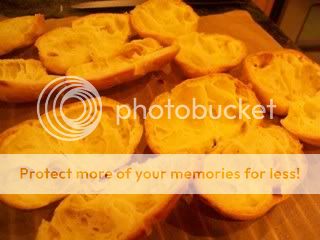
Pate a Choux is the name of the dough used to make cream puffs, eclairs, gougeres, and a number of other sweet and savory pastries. It literally translates "cabbage paste" because a baked puff looks like a tiny cabbage. People also call it as "choux paste"
"4,1,1,4" refers to the recipe I recently learned in culinary school. Just remember this number code and you will have a pate a choux recipe embedded in your brain forever:
- 4 ounces butter
- 1 cup water
- 1 cup flour
- 4 eggs
- 3/4 tsp salt, for taste
...don't forget the salt, which isn't in the code. You would still be successful if you left it out, it just wouldn't taste as good.
To make the choux paste, cut the butter into small pieces (about 1/2 TBS in size or smaller), and put the butter with the water in a medium saucepan over low heat. Bring it to a boil. *note: you do not want your water to start boiling before the butter melts because too much liquid will evaporate. That's why you cut the butter into small pieces and keep the heat low.*
Meanwhile, beat the eggs with a fork to break them up. Mix the salt and flour together.
When the water comes to a boil, dump the flour and salt in the stir with a wooden spoon until well-blended and resembles mashed potatoes. A lot of steam will come out. This is a good thing, because you want the paste to "dry out." Continue to stir the paste over low heat, until it gets shiny, more yellow in color, and smells like butter. These are your clues that the paste has dried out sufficiently enough to proceed with the next step.
Remove the saucepan from the heat and dump the paste into a large bowl. Allow to cool for a few minutes until just warm to the touch.
Stir in the beaten eggs with a wooden spoon, one at a time until each is absorbed in the paste. Test it by sticking the wooden spoon straight up and down in the center of the mound of paste. The spoon should start to fall over. If not, then there is not enough liquid. You may add a 5th beaten egg to achieve the desired consistency.
The paste will keep for 3-4 hours at room temperature.
Next steps...piping out the pate a choux...
The above picture shows pate a choux piped to form cream puffs. Use a large plain tip on your pastry bag to pipe out approximately 1.5" diameter circles. If they have points on top of them, simply smear them off with the tip of your finger after you wet it with some water. Be careful about how closely you space them, because they will double in size.
To form eclairs, pipe 2-3" long lines as shown below, with the large plain tip:
Mine are not all that tidy, but basically the idea is to make them oblong.
You can score them with a fork to make lines (not shown), and they look better this way.
Brush them lightly with egg wash before baking, and mop up any excess egg wash with a bit of paper towel.
Baking...
This is critical. The oven needs to be VERY HOT (475 F) during the initial stage of baking and YOU SHOULD NOT OPEN THE OVEN for at least 20-25 mins or until they have puffed and begun to firm up and are golden brown. After that, you can lower the oven to 325 and allow them to dry out this way for 10-20 more minutes.
Remove them from the oven and allow them to cool on a cooling rack before filling.
The inside of your pate a choux pastries should have a lot of air bubbles and have a light and fluffy consistency. The eclair shells below are an example of the correct texture:
Cream puffs and eclairs are filled with pastry cream. Below is an example of a savory puff, filled with herbs, cream cheese, and olives:
For savory puffs, you can ingredients such as add fresh herbs and parmesan cheese to the raw choux paste. The possibilities are limitless.
Here is the recipe for pastry cream to make cream puffs and eclairs:
Pastry Cream
1 1/2 cups half-and-half
4 large egg yolks
1/2 cup sugar
1/3 cup flour
pinch of salt
1 tsp vanilla
1/2 cup heavy cream
Heat the hald-and-half in a saucepan until just warm and steaming. In a separate bowl, whisk the egg yolks and sugar together to the ribbon stage. Stir in the flour and the salt.
Gradually whisk in the half-and-half. Transfer the mixture to a saucepan and cook over medium heat, stirring constantly with a wooden spoon until it becomes very thick. Be sure to whisk out any lumps.
Remove from the heat, add vanilla, and strain with a single mesh strainer into a bowl. Place plastic wrap directly on the surface of the pastry cream. Refrigerate until it just begins to cool.
Whip the 1/2 cup heavy cream to the soft plop stage. Fold about a quarter of it into the pastry cream to lighten it. Continue to fold in the rest of the whipped cream. Cover with plastic again and refrigerate until firm. Pipe as needed in cream puffs and eclairs.
For Coffee Flavored Pastry Cream:
Add 1 TBS instant coffee granules to the warm half-and-half at the beginning of the recipe.
For Chocolate Flavored Pastry Cream:
Stir 4 ounces finely chopped semisweet or bittersweet chocolate into the warm strained pastry cream.
To make chocolate glaze:
Melt 4 ounces of finely chopped chocolate in a double boiler or microwave. Add 1 tsp vegetable shortening, stir and allow to cool to desired consistency before applying.














